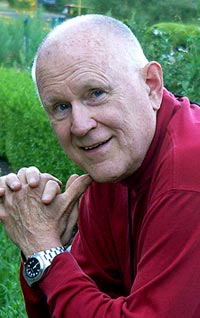Traditional diarists make choices about what bits of life to memorialize. But what if we could save life in its entirety? In today’s post, tech luminary and innovator Gordon Bell describes his efforts to do just that.

Photograph courtesy of Gordon Bell.
The work on capturing one’s life and putting it in cyberspace started with a 1998 request from a friend, Raj Reddy, a professor of Computer Science at Carnegie Mellon University, to scan all the books I had written. He wanted to put all the world’s books in cyberspace and wanted to start tests. This stimulated me to thinking about the scanning of all my own papers I had carried around in boxes for many years and that I could reclaim from Digital (who I had worked for). This eventually morphed into an experiment aimed at storing everything I had: articles, books, correspondence (letters, email), music, photos, videos, etc. This was completed by 2001 and I wrote a paper about the cost, benefit, sizes, etc. At this point the problem was clear: we could store everything, but the challenge was to organize it and above all find it again. This was the first epiphany.
We were inspired by Vannevar Bush’s 1945 article on Memex, a system that stored everything for a scientist—thus we had a goal for the system we created we called MyLifeBits. Bill Gates had written that “someday systems will capture everything you’ve seen and heard.” Finally we wanted to make a more useful system to organize personal records. Finally, based on the past work, we speculated that within a decade, disks would be large enough to store an entire life . . . that we first estimated to by only a Terabyte.
So in 2001 we (Jim Gemmell, Roger Lueder, and I) started a research project with a goal to explore the use of a database enabling the addition of arbitrary meta-data to facilitate the organization and utility. By 2005, the epiphany was that we had created a transaction processing system for one’s life, i.e. a system that could in principle capture every event in a life: computer activity, phone calls, time lapse photos using a SenseCam (one photo every 40 seconds), medical and health records, and every location. The project was stopped in 2007 because the Microsoft product plans changed and wouldn’t have the database we thought we needed.
We wanted to continue the work by laying out a vision that we described in Total Recall, by Jim Gemmell and me, that has just been republished in paperback as Your Life, Uploaded. In writing this, we had another epiphany—MyLifeBits is a surrogate memory. In the process we have explored issues like the ability and need for legacies and written about Digital Immortality.
Now with the invitation to speak at the Morgan’s exhibition on the diary, it triggered: What is the difference between MyLifeBits, a system to easily capture a great deal of one’s life, and a diary? Is it just the explicit act of reflection? Purpose?
Gordon Bell is a principal researcher at Microsoft working on lifelogging and cloud computing. During his twenty-three years as Vice President of Research & Development at Digital Equipment Corporation, he was responsible for the first mini- and time-sharing computers and the development of VAX. As the first Assistant Director for Computing (CISE) at the National Science Foundation, he led the National Research Network (NREN) panel that led to the development of the Internet. He is the author, with Jim Gemmell, of Total Recall: How the e-Memory Revolution Will Change Everything (2009), published in paperback as Your Life, Uploaded.
